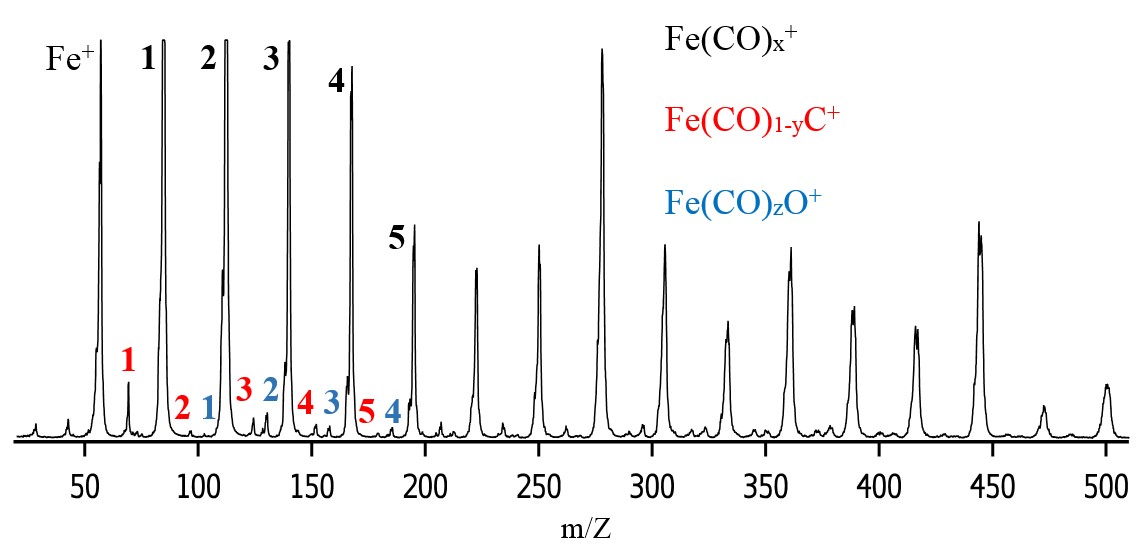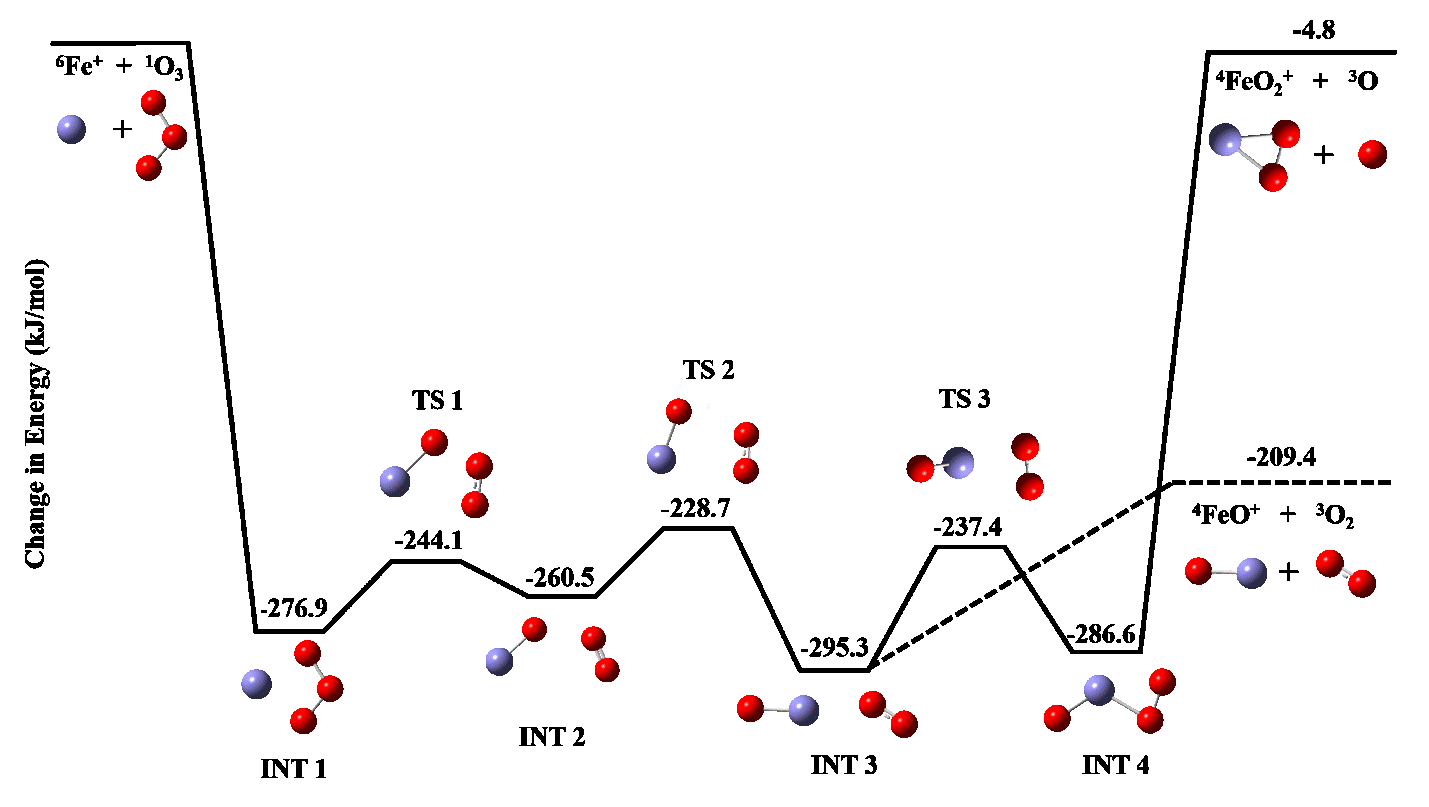Reports: UNI655479-UNI6: Mechanistic Details of Iron Based Fischer-Tropsch Catalysts: Ion Trap Experiments on Model Active Sites
Joshua J. Melko, PhD, University of North Florida
There is often still a significant gap between the understanding of fundamental features of reaction centers and the design of improved catalysts. Gas phase experiments can close this gap by studying physical characteristics and reaction mechanisms of isolated model active sites, which in turn may allow for the design of more efficient and selective catalysts. This research program studies the Fischer-Tropsch reactions on gas phase iron based systems, aiming to distinguish the preferred mechanism(s) and identify the reaction intermediates involved. These outcomes are achieved by experimentally measuring thermodynamic and kinetic quantities via ion trap mass spectrometry in conjunction with experimentally vetted computational methods.
Results from Year 1
Aim one of the research program involves the synthesis and isolation of the iron based Fischer-Tropsch active sites in the gas phase. These synthesized species are then used in aim two of the research to conduct kinetic experiments with appropriate neutral molecules in an ion trap mass spectrometer. Aim one has been accomplished in Year 1 as planned, and we are now transitioning to aim two. An example mass spectrum is shown below in Figure 1, which was produced, calibrated, and optimized by two undergraduate students utilizing the PI’s apparatus. Stoichiometries corresponding to Fe+, FexC(CO)y+, FexO(CO)y+, and Fex(CO)y+ are indicated in Figure 1. Peaks at higher masses represent similar series of Fe2 and Fe3 species. While these species provide the opportunity to study size dependent reactivity, which may correlate to surface morphology, those experiments are beyond the scope of the program described here. The ions in Figure 1 exist in (or can be optimized to) intensities sufficient to perform ion trap experiments.
Figure 1. Mass spectrum using a dilute Fe(CO)5 in helium mixture as the source gas. Undergraduates produced, calibrated, and optimized the intensity of this mass spectrum.
Also in Year 1, significant progress was made in the area of aim three, which employs computational chemistry to calculate structural and energetic parameters of the gas phase species, validating the methodology through comparisons with experimental data. Calculations have been performed within the Gaussian 09W package. Several methodologies were explored to treat the iron systems, benchmarking the approaches with experimental data in the literature such as ionization potentials, bond lengths, and spin energy splittings. We have found that density functional theory calculations with the B3LYP functional including D3 dispersion corrections with Becke-Johnson damping and employing the TZVP basis set provides a useful general picture of the intrinsic reaction mechanism at reasonable computational cost.
Subsequently we used our methodology to investigate the reaction mechanism for Fe+ reactions with ozone, using experimental data from collaborators. All intermediates and transition states of the reaction were explored at several spin multiplicities, since spin crossings are known to play a role in many reactions featuring iron. This iron/ozone reaction represented a good test case of our approach that should extrapolate to the kinetic experiments conducted in Year 2. As shown below in Figure 2, our calculations indicated the reaction proceeds through several intermediates and transition states before diverging into two product channels, corresponding to the FeO+ and FeO2+ ions. The lack of any significant kinetic barriers but a large difference in the exothermicity of the two reaction channels suggests the reaction should proceed efficiently, but produce mostly FeO+. This is in accordance with the experimental observations that the reaction proceeds at the collision rate, making only FeO+ without any FeO2+ formation.
Figure 2. Calculated reaction pathway for the reaction of Fe+ with ozone. All stationary points (INT for intermediate and TS for transition state) have sextet multiplicity. Intermediate three evolves either directly to the FeO+ + O2 product channel (dashed line) or through an additional transition state and intermediate to the FeO2+ + O product channel. Energies shown (in kJ/mol) are relative to the energy of the reactants.
Impact on PI and Students
The support of the Petroleum Research Fun has kick-started the PI’s research program, leading to several presentations and a manuscript submission. During the current funding period, three undergraduate students have worked on this project to accomplish the progress described above. In this short time, these three students have accounted for two poster presentations at a university symposium, four poster presentations at state conferences, one poster presentation at a national conference (The American Society for Mass Spectrometry’s National Meeting), one oral presentation at a university symposium, and one oral presentation at a state conference. In addition, two of these students earned authorship on a manuscript currently under review. This level of productivity would be impossible without the PRF funding, which has allowed these undergraduates to devote great chunks of time to research over the summer. The students learned tangible skills in working with high vacuum instrumentation, mass spectrometry, and computational chemistry, as well as the ability to analyze data, think critically, collaborate in a scientific environment, write manuscripts, and communicate scientific results. These skills have positioned them as competitive candidates for the next stage of their future scientific careers. Two of these students are now attending graduate school in chemistry, and the third is applying to medical schools.
The PI’s overall research productivity has been clearly enhanced by the support of the Petroleum Research Fund. This funding allowed the PI to concentrate on the training of students over the summer, it also provided materials and supplies for their experiments and the means to travel with undergraduates to disseminate the research. As a result, the PI is now in a position to leverage the initial findings into application for external funding. A Research in Undergraduate Institutions proposal was recently submitted to the National Science Foundation (Proposal #1665193), using results from this PRF program. In addition, the PI has presented the PRF results at state and national conferences.













